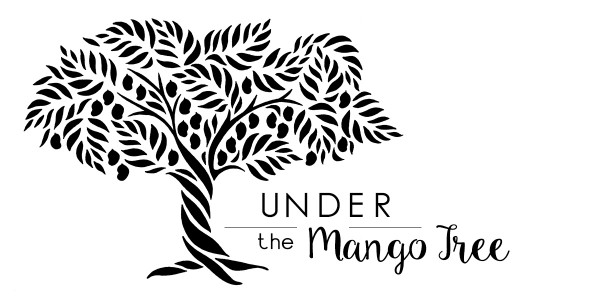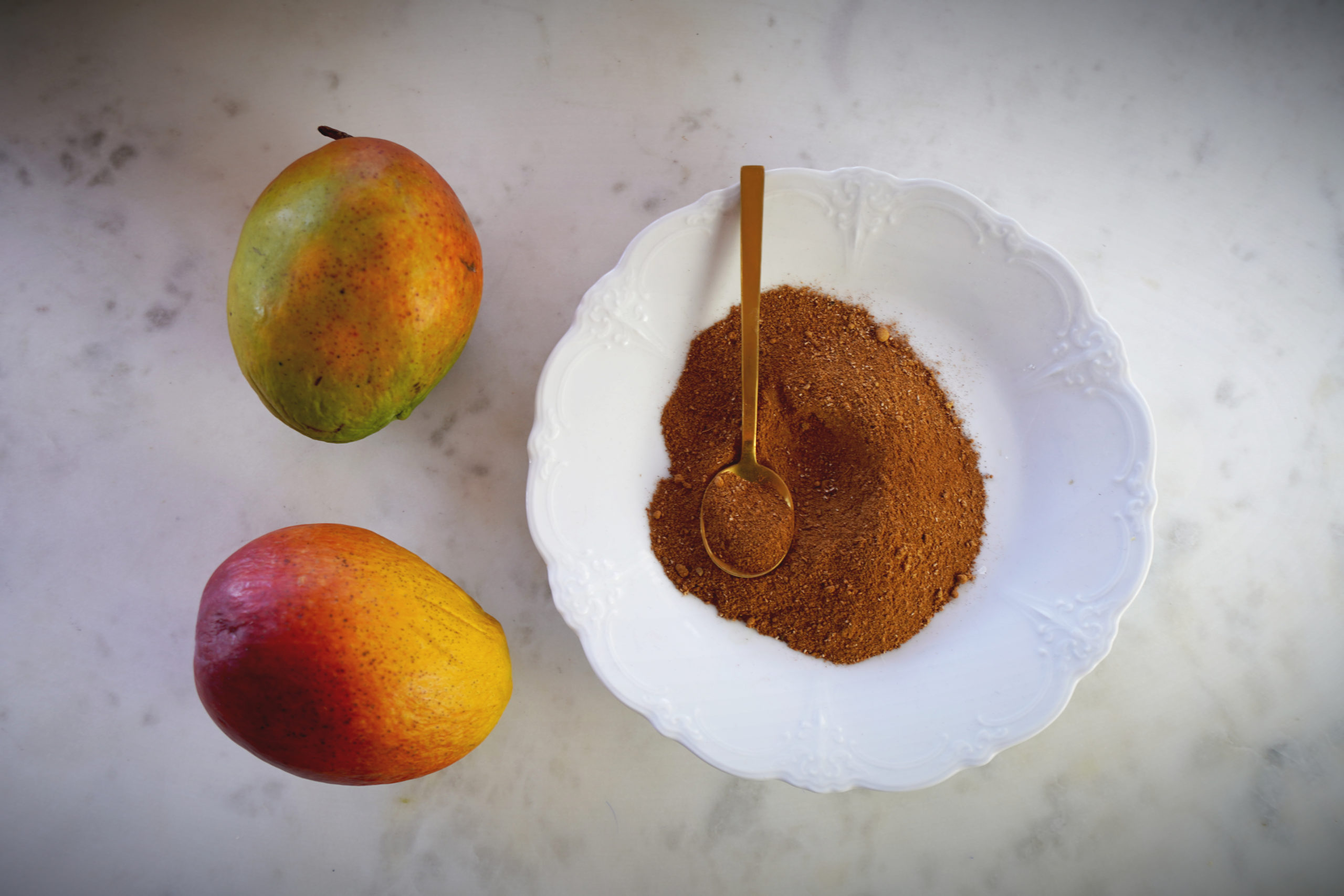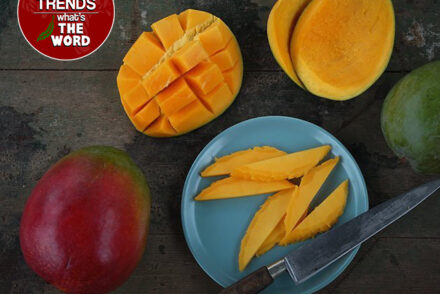Please, please stop throwing mango chunks into recipes recklessly…….
I love to cook; I assume that’s obvious, and if you know me even a little, you’ve probably guessed that I like to go rogue in the kitchen when it comes to tradition. After all, that’s how change is made—by pushing boundaries. And I am a big fan of change. Thanksgiving, for years, was a tough cooking holiday for me. No matter where I was or who I was with, the Thanksgiving table always felt like a showcase of flavors I didn’t totally love: too many carbs, too much sugar, and a whole lot of bland. The added element of massive elbow grease needed for both the prep and cleanup for just one BIG, whirlwind meal always seemed like a bunch of malarkey—especially since my Thanksgivings tended to have more football fans than helpful dishwashers (unless you count my loyal dog friends).
My rogue nature led me to experiment with ultra-creative Thanksgiving menus and recipes for years, but the truth is, they were never welcomed by my family or friends. Even though I had loyal fans of my cooking, they had little patience for me messing with Thanksgiving tradition. Eventually, I realized Thanksgiving was a much lonelier experience when I went rogue so at some point, I decided to leave my whimsy off the Thanksgiving table.
I gave in—maybe I grew up—and started cooking more traditionally for the holiday. Not only did I enjoy it more, but my dishes and flavors excelled like never before. I could add thoughtful, subtle tweaks to classic dishes, transforming them into something better without disrupting tradition. And those subtleties didn’t go unnoticed; my eaters appreciated them. It became a kind of “meet in the middle” approach, which I think can be a lovely center of joy and a timely reminder of how we create greater joy for more than just oneself.
Today, my always bountiful Thanksgiving table includes classics that carry a tinge of my personal essence and creativity. My Roasted Brussels Sprouts with Apples & Mint for example, offers eaters traditional Brussels sprouts, but the seemingly weird addition of fresh mint is where I go rogue, the result however is surprisingly rewarding. The mint gives the earthy Brussels sprouts a bit of freshness and vibrancy, while the apples bring in a tart and sweet balance with their caramelization during roasting. The dish is comforting yet light, which I enjoy more than fat drenched Brussels. Its traditional and provocative.
My Mezcal Cranberry Sauce, which has become a fan favorite on my table is both the sauce on my table and the muse to my herbal brine, which I use to dry brine my turkey every year, creating a smoky, savory and fruity essence with a tinge of chipotle spice that tends to stick to the skin of my bird and the “drippings” from the salt brine penetrate deep into the meat so each bite is an experience in gratitude for life.
I’m currently in the midst of planning a rather large Thanksgiving for friends and family at my new home in Northern California (I just moved back after four years in Missouri) and someone recently asked me what I was making with mangoes for my holiday table—a question I get asked lot around this time of year. Given my work and my passion for creating useful and delicious mango recipes, it seems like a natural question.
The surprising answer I often give is that I don’t think mangoes have a firm place in a traditional Thanksgiving without some thoughtful culinary expertise. To me, nothing about fresh mangoes screams “Thanksgiving.” And just because I create mango recipes doesn’t mean I throw them into just any dish. My advice for Thanksgiving and mangoes is simple: instead of forcing mango into recipes use mangoes in a more intentional way as an ingredient. Rely on their natural perfumed sweetness and their ability to morph into the most fall-centric flavor when cooked and paired with seasonal spices. Use their strengths and don’t force them to be something they are not.
This time of year, I notice an influx of mango recipes from marketing agencies and mango “influencers” that often feel careless. In my view, this approach is reckless, especially for those in positions of influence (which is not the same as being an influencer). It’s obvious they’re just trying to put mangoes on the Thanksgiving menu without much thought or skill behind it for the sake of marketing, and I understand the pressure… trust me I do.
One example I often see being passed around this time of year is roasted yams with chunks of mangoes ( yes, that would be chunks of hot mangoes mixed with sweet potatoes or yams)—a recipe that’s also needlessly complex, with multiple steps, and an end result that makes little sense for the traditional, simple and classic dish of roasted yams. It feels sloppy and purely marketing-driven, which isn’t useful to home cooks, and it doesn’t teach anyhow how to utilize mangoes in recipes and thus doesn’t create repeat recipe makers aka more mango sales. Don’t even get me started on the roasted Brussels sprouts recipes also with mango chunks strewn in that I see on my instagram feed. Chunks of mangoes should not be reckless strewn into any recipes, forethought mixed with skill is how to write recipes for the Thanksgiving table.
Creating recipes in general is a skill, and teaching people how to cook well with mangoes is important work in my opinion, so I don’t critique lightly—it’s something I take very seriously. If I were the one who was tasked with a sweet potato recipe with mangoes, I might have developed a recipe that uses (and teaches) the natural sweetness and caramelization that happens when mangoes are cooked and concentrated on mangoes for the glaze the yams. After all that is the best part about roasted yams, the crispy roasted outside combined with the silky inside, in a one taste bite. A mixture of brown sugar, spices, and mango purée could coat the yams before roasting, even going to far as adding marshmallows on top, since people seem to enjoy that. For a fancier Thanksgiving twist, I might go with a mango meringue topping instead of marshmallows, as that technique is not overly complicated, and a kitchen torch is fairly economical these days. Personally, I’m not a fan of sweet yams, so this isn’t a recipe I’d make for myself, but I do care about making sure that when people cook with mangoes, they learn to do it well, with recipes that truly work and taste good to them, so I think this recipe is an important lesson in the art of mango recipes and teaching.
Consider this post my best advice on the topic and your guide to incorporating mangoes into your Thanksgiving recipes, along with four of my personal favorites. These recipes are simple to prepare and sure to impress your guests if you choose to add a mango twist to your traditional Thanksgiving menu. Each one thoughtfully highlights mangoes in unique ways and in particular the warm comforting spiced nuances that evoke a comforting fall feeling. Disclaimer, mangoes will not be on my Thanksgiving menu because they don’t have to be in everything.
But yes, I am finally put my skill where my mouthy judgment is and I created the recipe I always said I’d make “if I were them”—Maple & Mango Spiced Sweet Potatoes. Spoiler alert: there are no chunks of mango in this dish, instead the dish reminds, as my others do, that fresh mangoes can be be enjoyed in many forms, showcasing their versatility and the culinary joy they bring. That, after all, is the true beauty of mangoes, the #MangoJoy.
Mango Nectar/Syrup
In my early days of mango recipe creation, I discovered the magic of mango nectar and the lush, tropical sweetness mangoes bring to cocktails and mocktails. This journey also inspired my ingenious Mango Pit Syrup recipe—a perfect blend of the “waste not, want not” philosophy and a versatile sweetener that requires little to no added sugar. Mangoes can play a significant role at Thanksgiving when incorporated into drinks, reducing sugar usage while adding depth of flavor and a velvety viscosity essential for crafting exceptional beverages. Their versatility shines through, whether showcasing fresh with their bright, tropical notes or their deep, warm, caramelized flavors when cooked. I think mangoes pair beautifully with some of fall’s seasonal gems, like cranberries and oranges. At my Thanksgiving gatherings, I often serve a Mango-Cranberry Satsuma Punch, perfect for kids and mocktail enthusiasts alike and Cranberry Blood Orange Mango Syrup, which is perfect for mocktails and cocktails. My Mango-Pit Margarita Mixer using fresh oranges or tangerines is perfect for a wowing seasonal Cranberry or Persimmon margarita. (Mango-Pit Nectar tip: Place your fleshy mango pits in a freezer bag or container and freeze until you get enough to make a big batch of syrup.)
Caramelization/Maillard Reaction
My greatest mango discovery lies in the complex flavors that develop when mangoes are cooked, thanks to caramelization and the Maillard Reaction. Mangoes caramelize beautifully due to their natural sugars—fructose, glucose, and sucrose—breaking down into rich, golden compounds under heat. The Maillard Reaction adds depth, where sugars interact with amino acids, creating warm, savory-sweet flavors and tender, jammy textures. (Mango Caramel 3 Ways).
Searing, roasting, and baking transform tropical mangoes into warm, golden delights with a sweet-savory balance while still holding a tinge tropical flair. The Maillard Reaction is best known for creating deep flavors and browning in cooked foods (it’s why you love the sear on a grilled steak). This chemical reaction occurs when amino acids and sugars react at high heat, typically above 285°F (140°C), giving roasted coffee, grilled steaks, baked bread, and toasted marshmallows their distinctive aroma, color, and taste. And yes, it’s mango’s best friend in the fall!
Caramelization and the Maillard Reaction should be your fall cornerstone mango cooking techniques—searing, roasting, caramelizing, and baking, turning fresh mangoes into sweet-savory, golden delights with a warm, smoky caramel flavor mingling with the fruit’s natural tropical flair. As sugars break down, they form compounds that create complex, savory flavors and golden-brown color. (Mango Dulche de Leche) The Maillard Reaction transforms mangoes into a tender, jammy texture while aromatic compounds enhance their fragrance, making cooked mangoes irresistible (Mango Jam).
Whether you’re making a Puff Present with Mango Jam for an appetizer or a Mango Dulche de Leche Flan for dessert, cooking the mangoes using caramelization and the Maillard Reaction techniques will bring out these unique flavors, you will get more than just a hot chunk of mango, you will get a richness you never expected, a taste you want more of, My Maple & Mango Spiced Sweet Potatoes, my Salted Mango Caramel, my Pie Spice Mango Hot Cocoa recipes, made with my Mango Pie Spice Puree, all demonstrate the use of these techniques beautifully.
Mango “Pumpkin Pie” Puree
Speaking of cooking mangoes and mango puree, did you know if you mix pie spice in with thick, ripe mango puree and cook it a little, it will taste much like pumpkin pie flavor? I love pumpkins, but roasting and blending them can be time-consuming, especially during busy holidays. A fresh mango, however, offers a quick and economical alternative, yielding a decadent puree that’s creamy and less dense than pumpkin. A mango pie spice puree carries tropical undertones, adding warmth with subtle brightness and a general lightness I adore, but the final result is deeply rich and comforting, and tastes just like pumpkin pie flavor. I made a Mango Pie Spice blend that I love for mangoes and coined the puree the Flavor of Fall. This mango puree delivers pumpkin pie vibes with tropical undertones, perfect for lattes, desserts, or even mango “pumpkin” pie. My Mango White Chocolate “Pumpkin” Spiced Latte embodies this concept, as does my Mango Mezcal Blush. Make mango versions of pumpkin pie, people do it every day. You could also make a mango version of my Pumpkin Basque Cheesecake, just make sure your puree is really thick, that is the beauty of cooking it, it will thicken up as you cook and the sugars will transfer and caramelize simultaneously.
Conclusion
Mangoes are a totally unique flavor of fall—versatile, comforting, and delightfully unexpected! They deserve a thoughtful place on every mango lovers Thanksgiving table.
By utilizing simple, thoughtful techniques to enhance the warm, spicy, caramel flavors of a tropical mango, we can coax out the best flavors for fall mangoes and create cozy, comforting dishes that still highlight the deliciousness of a fresh mango. With expertise driven recipe development, we can broaden the use of mangoes in cooking and give them a more traditional spot on our holiday tables.
Happy Thanksgiving!
May your table be traditional and tinged with creativity. May it bring real joy to you and your guests. And most of all, may you be blessed with plenty of cleanup help! -nissa
Cranberry Blood Orange Mango Syrup
This vibrant syrup blends the tartness of fall cranberries with the zesty, berry-like sweetness of blood orange, all perfectly balanced by the smooth, tropical richness of mango. Its bright, fruity profile is both tangy and sweet, making it a refreshing yet indulgent treat. It’s perfect for elevating cocktails, mocktails, and sparkling waters with a burst of fruity sophistication. It also makes a delicious drizzle for pancakes, desserts, or as a tangy-sweet glaze for roasted meats.
Makes 3 cups of syrup
Ingredients
2 cups of mango pit syrup
2 cups fresh cranberries
Zest of 3 blood oranges
Juice of 3 blood oranges
Method
Place the mango pit syrup, the cranberries and the blood orange zest in medium sauce pan and bring to a boil, let the mixture boil for about 5 minutes or until all the cranberries stop popping. Reduce and simmer for about 10 minutes longer. Strain the mixture pushing on the berries to extract all juice, discard the cranberry skins. Mix together with the blood orange juice . Bottle and refrigerate.
Pour a few ounces over ice and top with sparkling water. Or mix with your alcoholic spirit of choice. Bourbon is quite nice.
Smoky & Spicy Mango Cranberry Sauce
Cranberry sauce is a Thanksgiving essential, and it’s the perfect dish to personalize with unique flavors while keeping its classic cranberry essence. Adding mango, chipotle, and mezcal infuses it with a #HechoEnMexico vibe, creating a traditional-tasting cranberry sauce with a subtle kick of spice and a smoky, perfumed finish.
Makes 3 cups
Ingredients
2 cups fresh cranberries
1 cup fresh mango, cubed small
½ teaspoon cumin seeds
¼ teaspoon ground cinnamon
¼ teaspoon ground nutmeg
1 dried chipotle chili, chopped fine (seeds removed)
½ cup mezcal
1 tablespoon blood orange zest
Juice of 2 blood oranges
½ cup sugar
½ teaspoon salt
Method
Combine everything in a medium saucepan and bring to a boil. Reduce heat to medium and continue to cook, allowing all the cranberries to pop, stirring often. Once the cranberries have, all, popped open, reduce heat and simmer for about 20 minutes or until the sauce is thick. Make sure to stir often throughout the entire process. Allow to cool and serve either at room temp or cold.
Maple & Mango Spiced Sweet Potatoes (or Yams)
This recipe fully embraces tradition, even with the addition of mangoes. The natural sugars in mangoes caramelize beautifully, transforming the sweet potatoes into a comforting, warm dish—perfect for your Thanksgiving table or a cozy fall Wednesday. The unique flavor of caramelized mangoes envelops the sweet potatoes like a warm blanket of caramelized sweetness. The spices—cinnamon, nutmeg, and orange zest—add warmth and depth, while the optional pecans and marshmallows provide a nostalgic, crunchy-sweet contrast.
Serves 4
Ingredients
2.5 pounds sweet potatoes or yams, peeled and cut into 1-inch cube like pieces (about 5 cups)
1 tablespoon melted butter
2 tablespoons maple syrup
¼ cup thick mango puree
½ teaspoon ground cinnamon
¼ teaspoon ground nutmeg
1 teaspoon ground black pepper
1 teaspoon orange zest (optional)
1 teaspoon salt
1/3 cup chopped pecans (optional)
½ cup mini-marshmallows
Method
Preheat the oven to 425°F.
In a large mixing bowl, drizzle the sweet potatoes with the butter, maple syrup, and mango puree, and toss to ensure they are evenly coated. Sprinkle with the cinnamon, nutmeg, pepper, orange zest, and salt, then toss again to mix and coat everything evenly. Transfer the seasoned sweet potatoes to a large glass or ceramic baking dish and roast until tender, about 30 minutes. Once roasted, remove the pan from the oven and turn on the broiler. Place under the broiler for about 2 minutes to caramelize the tops of the sweet potatoes. Serve hot, warm, or cold, tossed in a salad.If you want to add pecans and/or marshmallows, toss them together and, before broiling, sprinkle them over the top. Broil until the marshmallows puff up and turn golden brown, keeping a close eye on them to avoid burning. Once done, remove from the oven and serve hot.
Mango Butterscotch Pudding Cups
The magic of butterscotch lies in the caramelization process, and with mango butterscotch, sweet mango purée merges with the deep, molasses-like richness of dark brown sugar and butter, enhancing the complexity with warm nuances and unique flavors of the caramelization in the mango’s natural sugars. This combination creates a warm butterscotch result with subtle warm fruity spice the result is rich, caramel-like, buttery, with deep molasses and vanilla notes in a silky pudding! Serve it with caramel and whipped cream for a decadent make ahead dessert.
Serves 4-6
Ingredients
1 cup whole milk
½ cup heavy cream
½ teaspoon vanilla extract
2 egg yolks (large eggs)
3 tablespoons cornstarch
1 cup thick mango puree
2 tablespoons salted butter
½ cup packed dark-brown sugar
¼ teaspoon salt
Method
Whisk together the milk, cream, and vanilla, then set aside. In a separate bowl, whisk the egg yolks and cornstarch together and set aside as well. In a medium heavy-bottomed saucepan, combine the butter, dark-brown sugar, and salt. Cook over medium-high heat until the butter and sugar melt into a smooth caramel-like liquid. Slowly and carefully pour in the mango purée, stirring constantly, and cook for another minute or two. Gradually whisk in the milk and cream mixture, allowing it to come to a boil. Once boiling, remove about 1/2 cup of the mixture and slowly whisk it into the egg yolk mixture to temper the yolks, whisking constantly to prevent the eggs from cooking.
Once tempered, pour the egg yolk mixture back into the saucepan with the mango cream. Whisk continuously over medium-high heat until the mixture thickens and begins to bubble, about 8 to 12 minutes. Reduce the heat to medium-low and continue whisking for an additional minute as the pudding thickens and bubbles. Remove the saucepan from the heat and let the pudding cool for 5 minutes. Pour it into serving glasses or bowls and cover tightly with plastic wrap pressed directly onto the surface to prevent a skin from forming. Refrigerate for 4 to 6 hours or overnight until fully chilled and set. Serve with a drizzle of mango caramel and a dollop of cinnamon whipped cream for a delightful finish.
This Mango Pumpkin Spice Cake has become a permanent fixture on many Thanksgiving tables. It’s easy, foolproof, and visually stunning—everything you want in a holiday dessert. With a subtle mango flavor paired with warming spices, it offers a tropical twist without overwhelming the senses. Inspired by African culinary traditions, where mangoes and pumpkins often meet in desserts, this cake combines exotic flavors with the comforting appeal of a traditional Thanksgiving spiced dessert. Serve it with No-Churn Persimmon & Mango Ice Cream or Mango Whipped Cream for the perfect finish.
Serves 6-8
Ingredients
1 tablespoon butter
2 ¼ cup flour
1 teaspoon salt
1 ½ teaspoons baking soda
1 teaspoon ground cinnamon
1 teaspoon ground ginger
½ teaspoon ground nutmeg
½ teaspoon ground all spice
½ teaspoon ground cardamom
1/2 teaspoon ground mace
½ teaspoon ground black pepper
1/2 cup sugar
1/2 cup dark brown sugar (packed)
1 cup canned or fresh roasted pumpkin puree
¾ cup olive oil (We like to use a blood oranges flavored oil from O brand oils and vinegars.)
4 eggs
2 teaspoons vanilla extract
¾ cup chopped mangoes, cubed small, plus several spears of mangoes, peels off (1-2 ripe mangoes depending on size)
Method
Heat the oven to 340F. Using the butter grease a 9-10 inch round cake dish or tall ceramic pie dish.
In a large bowl whisk together the flour, salt, baking soda and all spices. In another large bowl, whisk together the sugar, pumpkin puree, oil, eggs and vanilla until mix until smooth. Combine the flour into the pumpkin mixture and mix until all the flour is incorporated. Gently fold in ¾ cup of the chopped mango. Pour the batter into the cake pan. Arrange mango spears on top of the cake gently in a fan shape or design of your choice.
Bake for about 2 hours or until the thin tip of a knife interested into the center comes out clean. The cake may start to get too brown before the inside is cooked, if this happens simply place a little tin foil over the top of the cake to prevent it from burning.
Serve the cake with Mango Persimmon Ice Cream or Mango Whipped Cream.

















No Comments